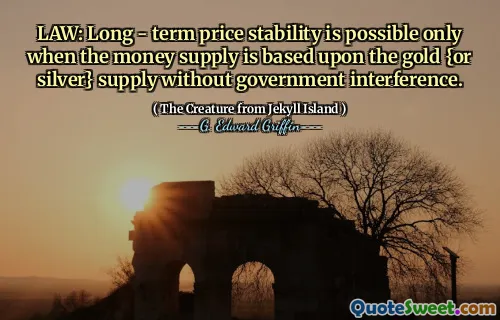
LAW: Long - term price stability is possible only when the money supply is based upon the gold {or silver} supply without government interference.
The quote emphasizes the importance of a stable monetary system rooted in precious metals like gold or silver, suggesting that government interference undermines long-term price stability. Historically, many economies operated on the gold standard, which limited the ability of governments to print excessive money, thus curbing inflation and fostering economic stability. This approach contrasts sharply with fiat money systems, where governments control the money supply, often leading to inflationary pressures or deflation, depending on policy choices. By anchoring currency to a finite resource like gold or silver, the monetary system inherently restricts the amount of money in circulation, aligning supply with actual demand and removing subjective government influence. Although some argue that the gold standard limits monetary policy flexibility, proponents believe that it provides a safeguard against reckless printing and political manipulation, ultimately preserving wealth and economic trust over time. The challenge lies in balancing the limited supply of precious metals with the dynamic needs of modern economies. Yet, when government interference is minimized, the stability seen in standards like the gold or silver standard demonstrates a resilient economic environment resistant to inflationary cycles. This perspective calls into question the effectiveness of centralized monetary control and highlights the potential benefits of returning to a more tangible, accountability-based monetary system. Overall, a gold or silver-backed currency could serve as a bulwark against economic instability precipitated by unchecked government interventions and might promote confidence among individuals and investors alike.







